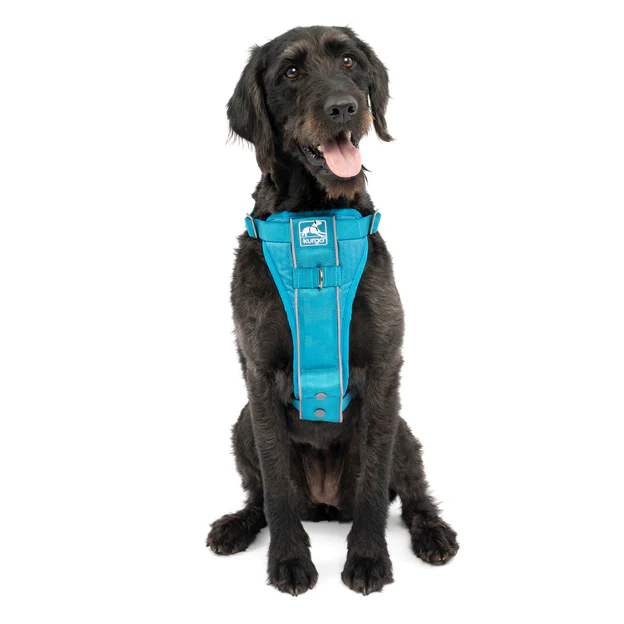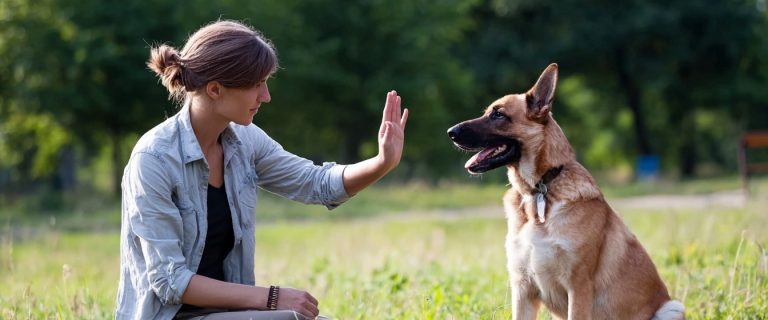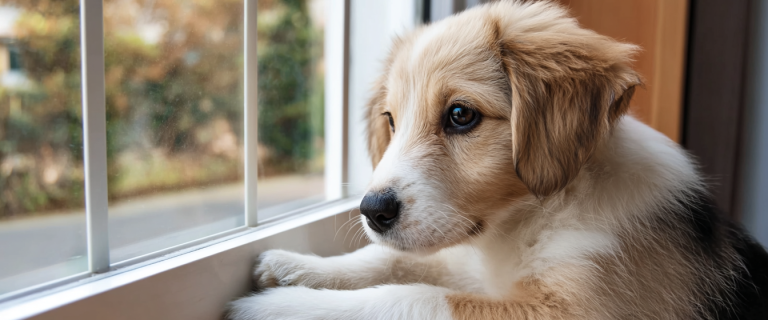How to introduce a new dog to an aggressive dog is something you might be looking up if you have a dog that has a very dominant personality.
You love the idea of having a second dog for you and your current dog to pal around with, but you’re unsure of how or even if you should try it.
Unless your dog has a long, clear history of being not only aggressive in some way, but outright violent, you should be able to introduce a new dog.
You’ll just have to take your time and do it right.
That’s why today we’re talking about how to introduce a new dog to an aggressive dog.
Related: How to introduce a visiting dog to your dog
Aggressive Dog Types

Most people think of a snarling, vicious, killer dog when they hear the word aggressive, but aggressiveness actually takes a variety of forms.
Of course, there’s the overtly aggressive dog that we normally think about.
This is the dog that really should always be in a one-dog household because he is just so aggressive toward any animal he sees.
However, there are also other forms of aggression.
It’s important to know which kind of aggressiveness your dog has so you can accurately assess if you can or should introduce a new dog into the home.
An important note here is that I’ll only be focusing on the main types of aggression that are most relevant to introducing a new dog to the household.
There are some forms of aggression that are more “in the moment” types that don’t readily apply to this post.
Those types of aggression can come from any dog, even if they have no history of aggressive actions and thus, have been left out of this post.
Predatory Aggression
This type of aggression is most often directed at another animal but can occasionally be centered on a person.
This aggression is predicated on the need to hunt, capture, kill, and consume another animal viewed as prey.
Prey can be rodents, cats, and smaller dogs. It’s usually devoid of precursor signs and the bite is uninhibited and often highly damaging.
Note: You should never attempt to bring another dog into your home if your current dog has predatory aggression.
Territorial Aggression
This type of aggression is directed toward animals or people who enter the dog’s territory – usually his owner’s home or property or the dog’s leash radius.
Guarding his territory is the dog’s way of ensuring both his safety and the safety of his owner.
This is most often seen in dogs that have been historically bred for guarding and have not been properly socialized.
Possessive Aggression
Also called resource guarding, this type of aggression is the result of a dog attempting to preserve his resources.
These generally include high-value items like food or toys.
Although this type of aggression can be in-born, it’s most often associated with strays who have lived a life of uncertainty when it comes to resources such as food, water, or a place to sleep.
An important note here is that possessive aggression can also be centered around a dog’s owner.
Some dogs view their owners as totally and completely theirs, and they will guard their owner just as they would a toy or food.
Fear or Anxiety Aggression
This type of aggression is based on self-preservation.
Aggression that is driven by fear or anxiety is caused by the dog’s fight or flight response.
This is most commonly seen in strays or dogs who have been abused in some way, although it can be in-born.
This aggression most often manifests if the dog feels cornered or trapped or if he is wound up by a trigger such as fireworks, storms, and the like.
Reactive Aggression
Reactive aggression is really a blanket term that involves fear, possessiveness, or territorial aggression.
This type of aggression is a reaction to a stimulus stemming from one of these other types of aggression.
Reactive aggression is not technically a form of aggression, I wanted to mention it here because the term is so often used.
Dominant Aggression
This is possibly the least “aggressive” aggression because the dog isn’t out to hurt the other dog.
He simply wants the dog to know that he runs things.
While this kind of dog isn’t driven by a need to kill, guard, protect territory, or by fear, he will forcefully assert his dominance.
So even this form of aggression can be dangerous if not properly handled or if the other dog is equally as dominant.
Related: how to introduce a puppy to a dominant dog
Understand Aggression Signs Before You Introduce a New Dog to an Aggressive Dog
Now that you know the most common forms of aggression, it’s time to identify which sort of aggression your dog has.
It’s usually fairly easy to spot, but if you’re on the fence, take a couple of weeks to observe your dog’s behavior.
- Does he lunge at other dogs?
- Does he growl when you try to take his food or a toy?
- Does he try to keep you all to himself?
These kinds of questions and observations will help you determine what kind of aggressiveness your dog has.
General Signs of Aggression
Outside of predatory aggression which typically shows little to no signs, there are signs that can be seen in almost every aggressive dog, no matter what kind of aggression he has.
You may see one or two of these signs, or you may see all of them.
We’ll take a look at them now, in order of escalation from least to most threatening, and then get into more specific signs based on aggression type.
- Avoiding eye contact (squinting or turning the head or body away from the threat)
- Yawning or licking the lips
- Pinning the ears tightly to the head
- Crouching, lowering the body, tucking the tail, or all of these
- Stiffening or freezing in place
- Growling
- Snapping
- Biting
Signs of Predatory Aggression
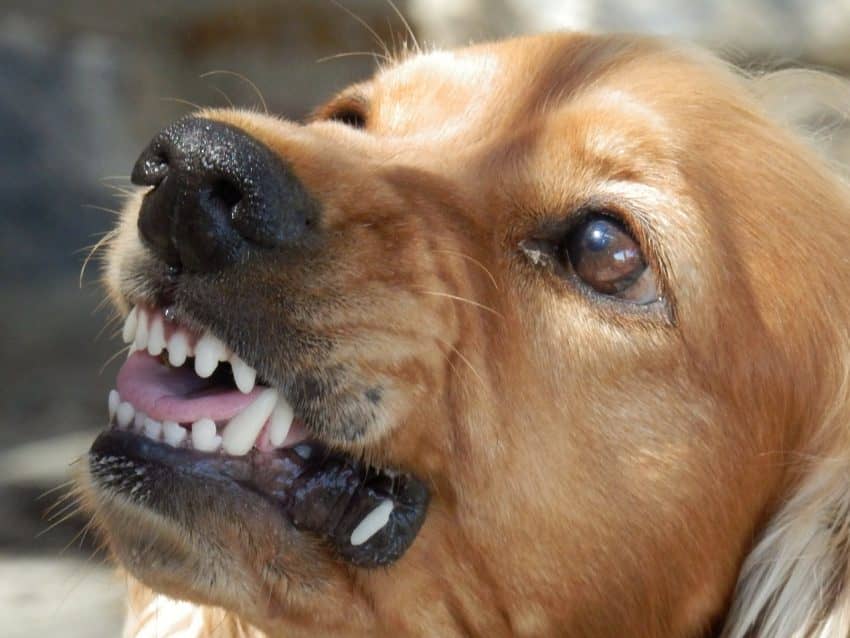
Predatory aggression is easy to spot. Unfortunately, it’s easy to spot based on outcomes, not on predictive signs.
Your dog will chase absolutely anything that moves. Maybe he’s already killed a few squirrels or even a neighborhood cat.
He is the picture of a good boy until he sees any creature smaller than him.
He might seem completely normal until another dog comes within range, and then he’ll lunge and bite at the other dog.
Again, this is not a dog that should have a buddy in the home, as this aggression can come out of nowhere and be deadly depending on the other dog’s size.
Signs of Territorial Aggression
The territorially aggressive dog will growl, bark, or nip at any perceived interloper.
This is most often seen when new people enter the home, but it is also seen when he’s on-leash in the form of lunging at other dogs or people.
Signs of Possessive Aggression

The possessive dog can be quite friendly until he feels like another dog or a person is going to try to take his stuff.
He’ll stand between his food, toys, or even his owner, crouching, growling, and keeping his hackles up.
He’s showing the person or animal that these things are his, and he doesn’t want to share.
Signs of Fear or Anxiety Aggression
Aggression related to fear or anxiety most commonly involves crouching low and attempting to get away to a safe zone.
This is a dog who does not want to fight but absolutely will to protect himself.
If he feels cornered, the dog will snarl, bark, and nip in an attempt to keep the perceived threat away from him.
Signs of Dominant Aggression
The biggest sign of dominant aggression is chest or body bumping.
This is a tactic used by a dominant dog to show the other dog that he is in charge.
From there, things can progress to growling, pinning, and sometimes nipping.
If the other dog is submissive, it usually stops there or even sooner.
However, if the second dog is equally as dominant, you could be looking at a full-on Thunderdome situation.
The Best Characteristics to Look for When You Introduce a New Dog to an Aggressive Dog
There are some general guidelines to consider when introducing a new dog to an aggressive dog.
Although every dog is different, following this look-outs will help you choose a dog that is most likely to fit into your other dog’s life.
Again, I want to stress that if you have a dog with predatory aggression he should be the ONLY dog in your home, period.
This aggression can come out of nowhere, and no amount of chaperoning can fully protect either your current dog or the new dog from one another.
Choose a Dog of Similar Size
It’s important to choose a dog of similar size.
This limits any accidental injuries due to size disparity.
For example, if a Mastiff and a Chihuahua decide to rough house, it’s likely that the little guy will get stomped.
Choosing a dog of similar size also makes your current dog think twice about getting physical.
It’s easy to push around a dog that’s ten times smaller than he is.
Choose the Right Sex
If you have an intact male, choose a neutered male for a partner.
Two intact males can have major dominance issues.
If you have a female, choose a neutered male.
Females tend to do better with males rather than with another female.
Often times, males will fight until one is too injured to continue the brawl.
However, females are more likely to literally fight to the death if they tangle.
It’s better to avoid that possibility altogether.
Territorial Aggression-Friendly Traits
If you have a dog with territorial aggression, choose a dog with a laid-back personality.
This will help limit the likelihood that the new dog will make your current dog feel that he has to protect his turf.
In addition, a “lazy” dog is also a great fit.
Breeds that love to lounge are less likely to elicit a territorial response in your dog.
Possessive Aggression-Friendly Traits
Again, choose a dog who isn’t pushy.
A dog with a friendly and intelligent demeanor works well with a dog who has possessive aggression.
This is because the new dog will simultaneously be fun for your current dog and learn the routines you set in place to reduce resource guarding quickly.
For example, the new dog will quickly catch on to the fact that he is fed in another room.
He will also quickly learn not to go after the other dog’s food or toys when you correct him.
A less pushy dog also works if your current pooch treats you as a possession.
A dog with possessive aggression targeted toward his owner is often called a jealous.
The key introducing a new dog to a jealous dog is to get a dog that will back off quickly to signs from your current dog and will also not push your current dog to “do something about” the new guy’s behavior.
Fear or Anxiety Aggression-Friendly Traits
Slow, steady, and lazy work best for a dog who has aggression driven by fear or anxiety.
The last thing your tightly wound pooch needs is a dog that is constantly trying to jump on him or otherwise invade his space at all times of the day.
Breeds that are basically lumps drastically reduce the likelihood of causing your existing dog to have even more anxiety than he already does.
Dominant Aggression-Friendly Traits
Opposites attract here. If you have a dominant dog, look for a submissive addition to the household.
Don’t worry, your current dog won’t abuse the new dog.
They will fall into the rhythm of the new dog following the current dog’s lead.
Be on the lookout for a dog who immediately flops onto his back when you approach. This is a sign of submissiveness.
However, be careful that you don’t mistake a submissive personality for a fearful one.
If the dog flops onto his back with his tail between his legs or urinates on the floor or himself, he’s most likely showing submissiveness due to fear.
How to Introduce a New Dog to an Aggressive Dog
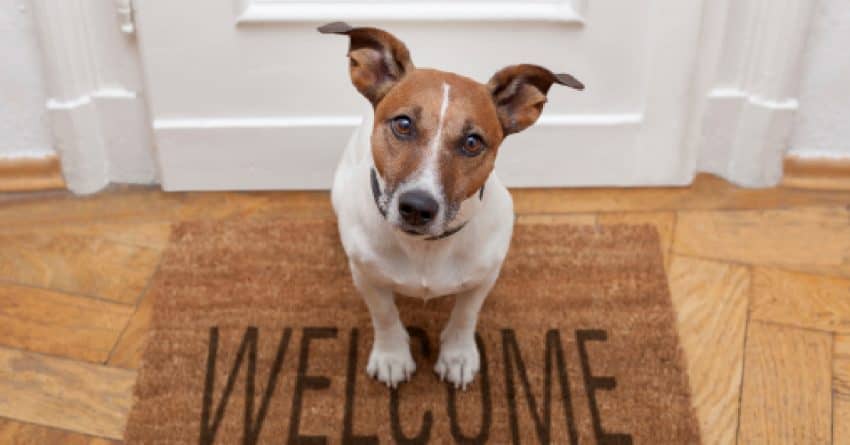
Now that you’ve figured out what kind of aggression your dog has, and you’ve found a new guy that will match your current dog’s personality, it’s time to make the introductions.
Remember, although there are many types of aggressive dog issues, they all have one thing in common: aggression.
You have to take things slow. You can’t force it.
Your current dog will warm up to the new guy in his own time.
Trying to make it happen any other way will increase the likelihood of a blowout that may injure either your dog or the new dog.
It can also make it impossible to create a safe environment for the two going forward.
I know this is probably sounding like a broken record right now, but again, do not attempt to introduce a new dog to a dog with predatory aggression.
In my time at the vet, I saw many injuries related to a dog with predatory aggression turning on his new pal for no apparent reason.
Just let him be the only dog. He’ll be happier, and so will you.
Introduce the Dogs on Neutral Turf

Owners who don’t have an aggressive dog can normally simply make introductions in their front yard.
However, owners who have a dog with any form of aggression should make introductions in neutral territory.
In general, this means using the Parallel Walk Method. This method allows for calm introduction using movement and distance.
Use Leashes and a Harness –
This is a first-time meeting, and there’s a possibility that your dog might lunge.
You don’t want him on a choke or prong collar if that happens.
Choose a comfortable harness that will allow you to retain control and won’t choke or injure your dog should he lunge. We like this one by Kurgo:
The Tru Fit Smart Harness with quick release buckles is designed to do one thing: get on fast, so you and your dog can get going. Just slip it over his head and clip a couple buckles, and you’re ready. And when you're done with your adventure, one press has him out just as quickly.
Walk the Dogs Parallel on Opposite Sides of the Street –
This allows both dogs to be within view of the other without being too close.
It’s a way for the aggressive dog to get acclimated to this newcomer without feeling invaded.
Reward Eye Contact –
Whenever your aggressive dog makes calm eye contact with the new dog, reward him with a treat.
Remember, looking away from the dog is the first sign of agitation or aggression, so it’s important to reinforce that direct line of sight.
Use Obstacles for Breaks –
While introducing a new dog to an aggressive dog, it’s important to give the aggressive dog breaks.
It’s a slow process.
Use obstacles or barriers like hedges, cars, or other things that block your current dog’s view to occasionally give him a break from being in the new dog’s presence.
Gradually Close the Distance –
Either turn onto a smaller side street or make your way to a park where the dogs can be moved progressively closer to one another.
Continue to reward eye contact with treats.
Allow Your Aggressive Dog to Approach the New Dog –
Keep some slack in the leash, while allowing your aggressive dog to check out the new guy.
A loose leash sounds like a bad idea, but it’s key here. A tight leash can send your dog a message to be on guard.
Remain calm but vigilant. After a few seconds separate the dogs and reward your guy with a treat.
Repeat –
Remember this is a slow process.
It will take several sessions to get to a place where your current dog is tolerant to the new dog, and there may even be setbacks.
That’s okay.
Home Management When Introducing a New Dog to an Aggressive Dog

The following tips should be used to introduce your new dog to your aggressive dog, no matter what kind of aggression he may have.
Whether you’re introducing a reactive dog or another dog, introducing a puppy to an aggressive dog, or dealing with a dog who has aggression secondary to fear, all of these tips will help mitigate stress for your current dog and hopefully lead to a smoother transition.
- Use closed doors, dog or baby gates, or crates to feed the dogs separately.
- Keep separate water bowls down to limit the chance of the dogs attempting to use the same bowl at the same time.
- Be vigilant of body language so you can step in if things get tense.
- Be cognizant of interactions around toys and beds.
- Always watch closely when the dogs play.
- Exercise both dogs well. A tired dog is a happier dog.
- Adequately train your dogs so that each responds immediately to commands like sit, stay, lie down, and leave it to help reduce tense situations.
- NEVER use punishment to correct behavior. Rather, distract from the behavior whenever possible and reward the things you want your dogs to do.
- Give adequate attention to both dogs. Don’t favor the new dog to make him feel more at home. This can cause your current dog to want to guard you as a resource.
- Take it slow. After introductions, getting used to living together is a slow process.
Use the Tips on How to Introduce a New Dog to an Aggressive Dog
Whether your dog is territorial, fear-based, or something else, in most cases these tips can help you introduce a new dog to an aggressive dog.
Remember to take things slow and don’t force anything.
If you let your current dog take the lead, he’ll be more likely to feel comfortable and less likely to initiate aggressive behaviors.
When you introduce a new dog to an aggressive dog, it’s a game of inches. Take your time, and you’ll be okay.
Have you ever introduced a new dog to an aggressive dog? Share your experiences below.
Author
-

A former Veterinary Assistant at Southwest Animal Care Hospital, Ben is an animal lover, blogger, and all-around geek. Along with writing for DogVills, Ben runs his own virtual assistant company, BizzyBim.
View all posts

